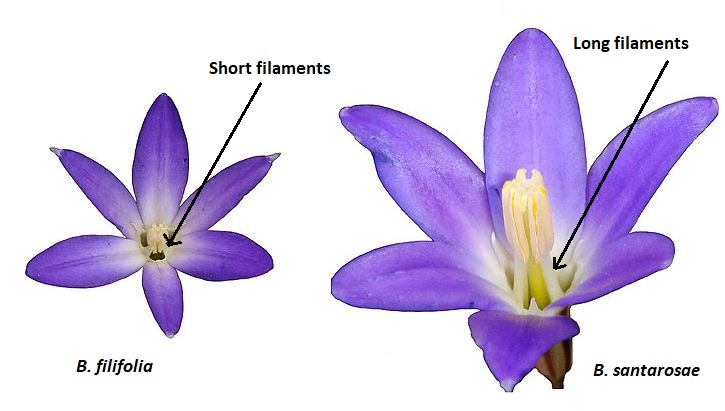Distinguishing Brodiaea santarosae and B. filifolia

Fig. 1. The flowers of Brodiaea santarosae and B. filifolia, shown at the same scale, from Wayne Armstrong (see original page with a ruler in the image). Note that the flower of B. filifolia is significantly smaller, and that it has extremely short filaments, typically just 0.5 mm in length. The filaments of B. santarosae are typically 10 times longer, 5.5 mm in length.
This page was created because there was significant confusion at iNat as to how to separate Brodiaea santarosae and B. filifolia.
This page gives a pictorial guide to distinguishing those two species.
I had intended to also give a geographic map of where the two species are found along the trails of the Santa Rosa Plateau Ecological Reserve, since the two species are never found in proximity. But unfortunately, I realized that putting a map online would allow poachers to dig up corms of these species, so I decided against putting that online.
There is a misconception that all the plants growing on basalt soil at the Santa Rosa Plateau that look like B. filifolia or B. santarosae are the latter. That is not correct! There are large populations of true B. filifolia at the Santa Rosa Plateau, as well as large populations of B. santarosae. The map published in the paper defining B. santarosae shows that both species are found on the Mesa de Colorado.
There is another misconception that the plants at the Santa Rosa Plateau are part of a "metapopulation" in which there is continuous intergradation between the species. That is not correct! That misconception came before B. santarosae was recognized, when plants of that species were variously mistaken as B. filifolia, B. orcuttii, or a hybrid between those. It was even thought that B. terrestris ssp. kernensis participated in that "metapopulation" because there are rare hybrids of B. terrestris ssp. kernensis with both B. filifolia and B. santarosae. What was not realized at the time was that the rare hybrids were easily recognized as such because they have sterile anthers. Because Brodiaeas reproduce clonally by corms, those rare hybrids can form a clonal patch, all genetically identical. See Wayne Armstrong's Hybrid Brodiaea On The Santa Rosa Plateau.
All specimens at the Santa Rosa Plateau can be unambigously determined as a pure B. filifolia, B. santarosae, B. terrestris ssp. kernensis, or immediately determined as a hybrid of B. terrestris ssp. kernensis with either B. filifolia or B. santarosae!
We have never seen a hybrid of B. filifolia with B. santarosae, probably because those two species do not grow in the same locations. In contrast, B. terrestris ssp. kernensis is very common at the Santa Rosa Plateau, giving it much more opportunity to hybridize with the other two species.
Pictorial Guide to Distinguishing Brodiaea santarosae and B. filifolia
B. santarosae and B. filifolia can be easily distinguished as follows.
Flower size. The median flower length of B. filifolia is 22 mm, measured from the base of the flower to the tip of the corolla lobes when the lobes are held erect. The median flower length of B. santarosae is 28 mm, 27% longer. Fig. 2 shows a comparison of the lengths for randomly-sampled flowers from two locations. Of course, sizes are impossible to deduce from a photograph without a scale in the picture, such as one's finger.

Fig. 2. A comparison of B. filifolia flowers (the small ones) from the moist area surrounding the largest vernal pool on the Mesa de Colorado, and samples of B. santarosae (the large ones) from the top of Clay Hill just west of the Mesa de Burro, which was very dry on 1 June 2006.
Filament length. The filament is the stalk under the yellow anthers that hold the pollen sacs. The filament length is significantly shorter for B. filifolia than for B. santarosae. A photograph from a side angle usually shows this clearly; see Fig. 1.
Staminode length and orientation. A staminode is a structure similar to a stamen, but which lacks anthers. The separation between these two species using the staminode is not always definitive, but often gives a pretty clear separation. The staminodes for B. filifolia are always present, 1.0 to 4.5 mm long, are almost always reflexed against the perianth, and all three staminodes are always identical. The staminodes for B. santarosae are not present in as much as 50% of its flowers. When they are present, they are 0.0 to 7.0 mm long, recurved to erect, and are sometimes different within a single flower. For many examples, see Wayne Armstrong's Floral Variation in Brodiaea santarosae.
There are a number of other distinguishing characteristics between these two species; see a more complete discussion about how to separate B. santarosae from all other Brodiaea species in southern California.